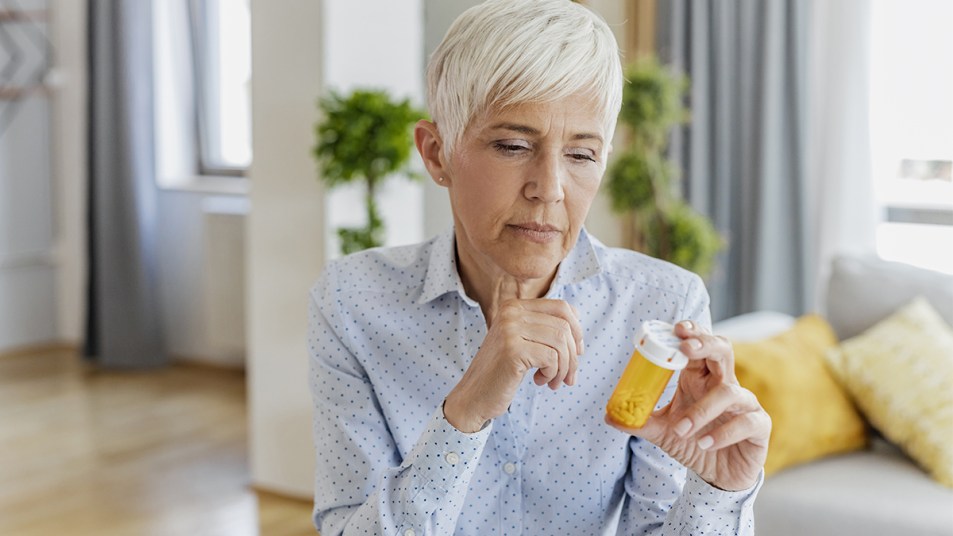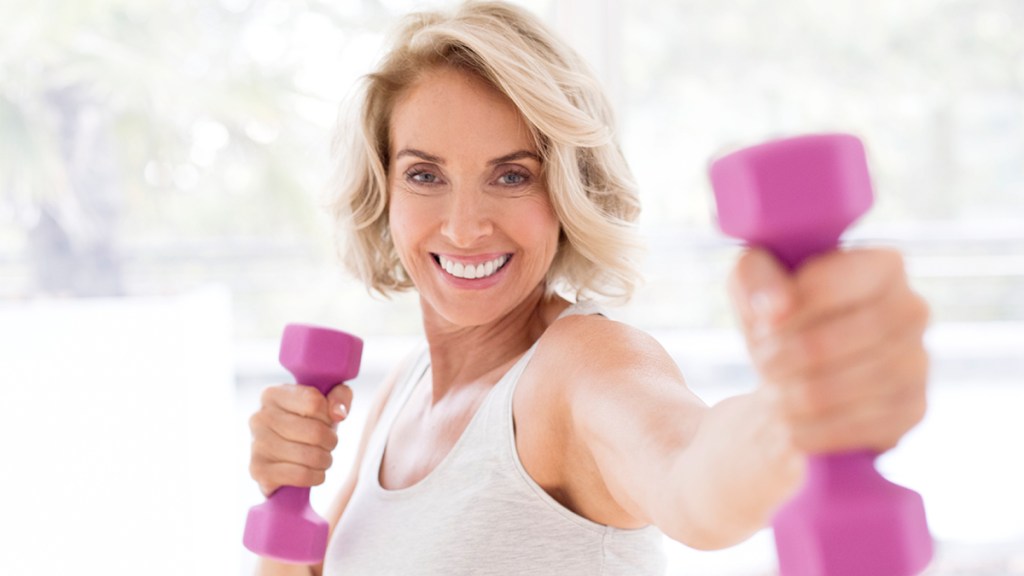Fosamax and Other Bone-Building Drugs Have Been Linked To a Higher Risk of Broken Bones: What Doctors Want You to Know
MDs share natural bone builders that may be good options for certain women

If you’re one of the 8 million American women with osteoporosis, your doctor has probably talked to you about treatment options to slow the disease’s progression and keep your bones in tip-top shape. One common therapy used to manage bone loss is a class of prescription drugs called bisphosphonates, which include the brand-name drugs Fosamax, Actonel and Reclast. These medications are great at strengthening bones and preventing fractures, but they can also present a wide range of side effects, including an increased risk of broken bones! Below, we take a closer look at Fosamax side effects and offer some all-natural solutions for keeping your bones healthy and strong.
What are bisphosphonates?
Bisphosphonates are a group of medicines that treat osteoporosis and other bone-related health problems. Bisphosphonates can be taken as pills or by an IV infusion. Pills are usually taken once or twice per day on an empty stomach. Intravenous bisphosphonates are given either once yearly (Reclast) or every 3 months (ibandronate). These infusions can take anywhere from 15 minutes to 4 hours, depending on which bisphosphonate is given.
Who do bisphosphonates work?
To understand how bisphonates work, you need to know how your body makes bone tissue. Here’s a quick breakdown: Your bones constantly regenerate. Each day, your body breaks down and absorbs old bone and then replaces it with new, healthy bone tissue. Aging speeds this process up, eventually causing your body to absorb bone quicker than it can produce it. This results in osteoporosis, a bone disease that increases your risk of fractures. Bisphosphonates slow down your body’s ability to absorb old bone. This helps strengthen your bones and keeps them from breaking.
5 main side effects of Fosamax
Bisphosphonates can be taken orally, like alendronate (Fosamax) and risedronate (Actonel) or intravenously, like zoledronic acid (Reclast). The drugs are powerful and effective, but nutritionist and bone-health expert Susan E. Brown, PhD, Director of The Center for Better Bones and author of Better Bones, Better Body, cautions, “Times are changing and people are starting to see the problems with these [bisphosphonate] medications. There’s no miracle drug.” Potential side effects include:
Side effect of Fosamax: gastrointestinal problems
“For oral [bisphoshonate] medications, GI side effects are the most common,” says Ann E. Kearns, MD, PhD, a board-certified endocrinologist at Hinnepen Healthcare in Minneapolis, Minnesota, who recently retired from the Mayo Clinic after 25 years treating patients with osteoporosis. “This can include bloating, abdominal pain, constipation or diarrhea and heartburn.” (Click through for tips on how to get rid of heartburn at night.)
Fosamax can also increase the risk of gastric ulcers, open wounds that form in the stomach lining. The goods news? Dr. Kearns says that mild GI symptoms tend to improve once your body adjusts to the medication.
Side effect: muscle pain
Bone, joint and muscle pain are common symptoms of osteoporosis, but a growing body of research suggests that “serious or severe bone, joint, and/or muscle pain [can] begin shortly after bisphosphonate therapy.” For people who experience this medication-induced pain, Dr. Kearns, who’s also the author of Mayo Clinic on Osteoporosis: Keep Your Bones Strong and Reduce Your Risk of Fractures, says symptoms typically subside after stopping the medication. Bottom line: If you experience significant muscle pain, talk to your doctor to switching to another treatment approach (more about those below).
Side effect of Fosamax: jaw pain
A rare, but potentially severe side effect of Fosamax is osteonecrosis of the jaw (ONJ). “The symptoms of this are a sore or exposed area of [jaw] bone that is slow to heal,” explains Dr. Kearns., who recommends seeing a specialist, like an oral surgeon, if you develop this symptom.
To reduce your risk of ONJ, Dr. Kearns recommends practicing good oral hygiene: Brush your teeth twice daily, floss regularly and visit your dentist for routine checkups. If you use tobacco products, try quitting those as well.
Side effect: broken bones
The most surprising — and alarming — side effect of bisphosphonates: broken bones, particularly in the thigh bone. “The refrain I hear from patients is, ‘Why should I go on a drug that can cause fractures…to prevent fractures,’” says Clifford Rosen, MD, a professor at Tufts University School of Medicine.
Dr. Kearns says these fractures often begin as a small crack in the thigh bone that causes mild pain — without injury to the bone. But eventually, the bone breaks completely. Pain the middle of the thigh is a key symptom. Anyone taking antiresorptive medications [like Fosamax] should discuss thigh pain with their doctor, who can assess it with X-rays,” she says.
Side effect of IV Fosamax: flu-like symptoms
If you’re considering intravenous bisphosphonate therapy, be aware of potential flu-like symptoms, says Dr. Kearns. “These symptoms include fever and malaise, like you might experience with a virus. Severity is usually mild, but some people get these symptoms worse than others,” explains Dr. Kearns, “The risk of this reaction is highest with the first infusion and much less with subsequent ones.”
Who should avoid taking bisphosphonates?
Bisphosphonates are an important tool in the fight against osteoporosis, but they aren’t for everyone. Dr. Kearns says you might benefit from another form of treatment if you have digestive health problems, difficulty swallowing or trouble adhering to a dosing regimen. Likewise, if you have active dental issues, like cavities or gum disease, it’s important to address those issues first, as they can increase your risk of ONJ. (Click through for dentists’ top tips for gum disease self care.)
How to stop taking bisphosphonates
Most people tolerate bisphosphonates, like Fosamax, well, but if you develop severe symptoms such as the ones listed above, Dr. Kearns advises stopping the medication immediately and contacting your doctor. Quitting won’t necessarily harm you because “when these medications are stopped, the benefits to bone persist for some time,” she says.
Adds Dr. Kearns, “this allows the medication to be taken for a few years and then followed by some time off, like a ‘vacation’. How rapidly the effects wane after stopping is different for each person, so usually, the periodic assessment of bone density is recommended.” Indeed, research shows some benefit to ‘drug holidays’ for women taking bisphosphonates long-term.
If you decide to stop taking these medicines, or decide not to take them in the first place, it’s important to work with your doctor, who can develop a personalized treatment plan (including prescribing alternative medicines) and monitor your progress to ensure your bones stay healthy and strong.
How to strengthen your bones naturally
Bisphosphonates offer serious benefits if you’re postmenopausal and suffering from bone loss, but weighing the pros and cons is essential. “If you’re in a corner, you might have to take [bone-building drugs], but you want to try to do everything possible to maintain and build bone strength because it’s good for your whole body,” says Dr. Brown. Here, the best ways to do so:
Bone builder: Alkaline foods

We all know that eating a healthy diet reduces the risk of high blood pressure (hypertension) and high cholesterol, but evidence also suggests that a nutrient-dense diet can protect your bones. Dr. Brown, who’s also an anthropologist, agrees, noting that “if you look around the world, you see that cultures that eat fresh whole foods, and more specifically, a lot of plant foods, have much better bone health.”
Dr. Brown encourages women at risk of bone loss to eat plenty of vegetables, fruits, nuts, seeds and spices. Vegetables and fruits with adequate protein are especially important, such as beans, collard greens, asparagus, avocados, and apricots.
“The diet most highly associated with bone strength is the alkaline diet,” she adds. “This nutritional plan tries to reduce excess acidity in the body. Acid load comes from things like sugar, alcohol, grains, and meat,” she says. “Consuming a high-mineral diet with potassium, magnesium, and of course, calcium, helps buffer that acidity.” The foods you eat on an alkaline diet include plenty of fruit and vegetables, potatoes, and high-fat plants like olives, nuts, and avocados. (Click through for more on alkaline diets and an alkaline cleanse that can also help you lose weight.)
Bone builder: Regular exercise

“All exercise helps your bones,” explains Dr. Brown. “But resistance or strength training is especially beneficial.” A scientific review published in the peer-reviewed journal Medicine & Science in Sports & Exercise confirms this, noting that nearly two dozen studies have shown a direct link between resistance training and improved bone density.
You can find hundreds of weight-lifting workouts for free on YouTube, including this Osteoporosis Workout from @JessicaValantPilates:
Or try BODYPUMP., which emphasizes moderate weight training with barbells. You can do the workouts at home or take in-person classes at many gyms. And it’s a proven bone-health booster: Researchers at Penn State University found that participants who did BODYPUMP workouts 2 to 3 times weekly experienced increased bone mineral density in their arms, legs, pelvis, and spine. (Click through for 80s workout videos that will take you on trip down memory lane and improve bone health!)
Bone builder: Balance moves
It’s also a good idea to work on balance exercises, says Dr. Kearns. “Balance is important to work on to lower the risk of falls, which can be the event that causes a fracture or broken bone.” Integrative medicine specialist Katie Takayasu, MD, assistant professor of Clinical Medicine at Columbia University/New York-Presbyterian, recommends this easy “flamingo” move: “Just lifting one foot in the air and balancing on one leg for a minute [then switching legs] while you’re brushing your teeth every day trains your muscles to support you, improving balance and helping to prevent falls,” she says. (Click through to discover how a balance board may help improve your balance.)
Bone builder: These supplements
Calcium and vitamin D play a crucial role in bone health, but they aren’t the only nutrients responsible for building bone and keeping it strong. “Science is starting to recognize vitamin K and vitamin K2 (MK-7) as very important for bones,” Dr. Brown says. “Both increase bone mineral density and help reduce fracture rates.” (Click through for more on vitamin K benefits for arthritis.)
Other supplements to consider include magnesium, which stimulates the production of osteoblasts (bone cells), and potassium, which neutralizes acid load and reduces calcium loss from bone. (Click through for more on the best types of magnesium for your health, from magnesium glycinate to citrate and more)
Dr. Brown’s company, Alkaline For Life, offers several nutritional supplements formulated to support bone and muscle health. One to try: Energized Multi+ (Buy on AlkalineForLife.com, $27.50 for a 30-day supply) which contains calcium, magnesium, potassium and vitamins D and K-1. (Interested in additional supplements? Click through to discover the best bone-boosting DHEA for women.)
Note: Dr. Kearns advises speaking to your doctor before taking supplements for bone health.
Bone builder: Managing stress
Women are twice as likely as men to suffer from severe stress and anxiety — emotions that can also affect your bones. “Worry damages bone. This is partly because cortisol (stress hormone) levels increase during menopause,” explains Dr. Brown. That’s bad news for your bones, since high cortisol levels have been linked to an increased risk of osteoporosis. (Click through for easy ways to lower cortisol in the morning.)
Specific activities, like yoga, breathing exercises, and guided meditation, are effective ways to combat the ups and downs of life. Adds Dr. Brown, “ I encourage all women to check in on their emotional health. Look at what you need to do to be happier and reduce the tendency to worry.” (Click through for how to practice one powerful breathing exercise called cyclic sighing.)
This content is not a substitute for professional medical advice or diagnosis. Always consult your physician before pursuing any treatment plan.
















